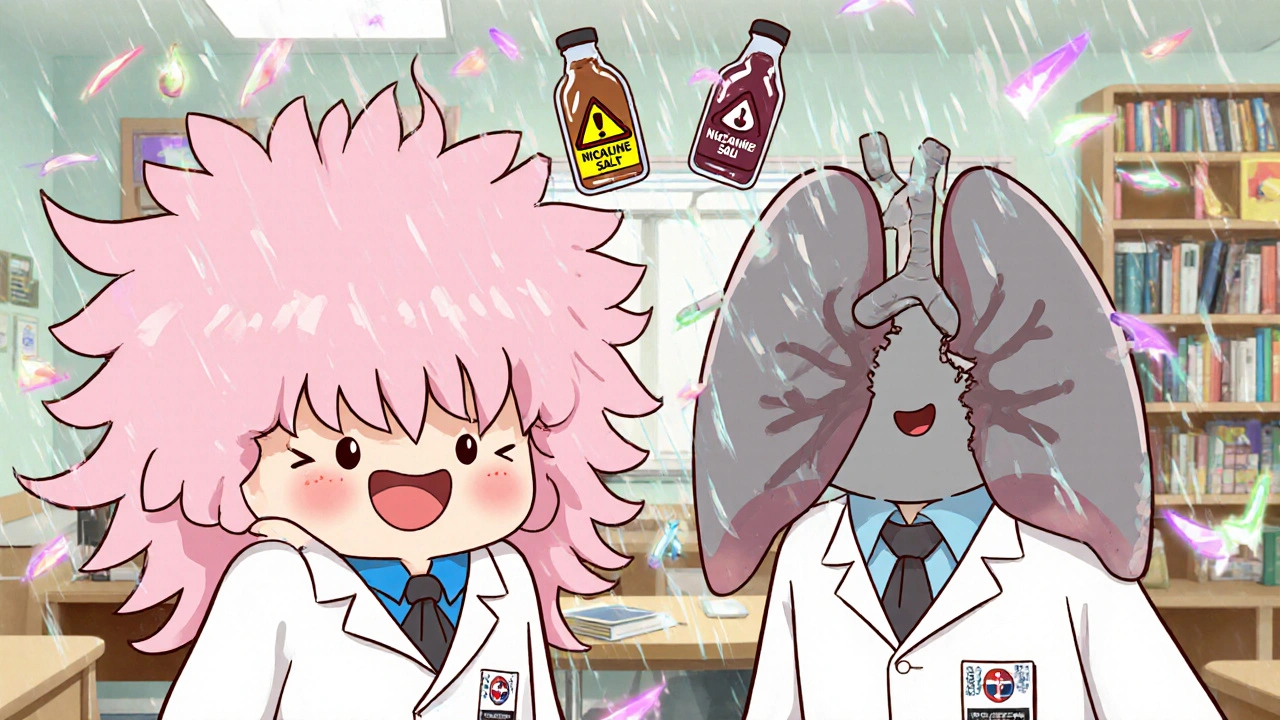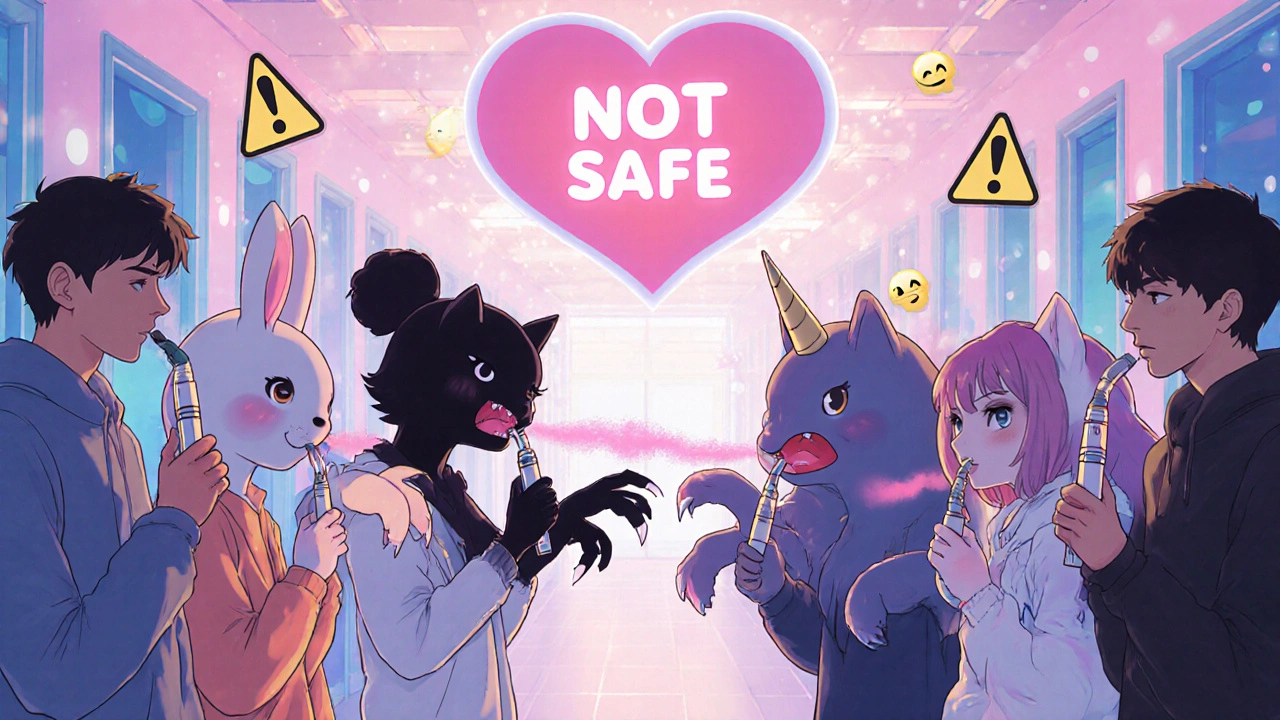When you see someone puffing on a sleek vape pen, it’s easy to assume it’s just water vapor-harmless, even healthy compared to cigarettes. But the truth is more complicated. Vaping isn’t clean air. It’s a mix of chemicals heated into an aerosol, and every time you inhale it, your lungs are reacting. By 2025, the science is clear: vaping isn’t harmless. It can damage your lungs, weaken your immune system, and increase your risk of serious breathing problems-even if you’ve never smoked a cigarette.
What’s Really in Vape Aerosol?
Most e-liquids contain propylene glycol and vegetable glycerin, two ingredients that seem harmless on paper. But when heated and inhaled, they break down into toxic byproducts. A University of North Carolina study found these substances are toxic to lung cells, and the more additives in the liquid-like flavorings or nicotine salts-the worse the damage. You’re not just breathing in flavor. You’re inhaling chemicals like acetaldehyde, acrolein, and formaldehyde. These are known to cause airway irritation, inflammation, and long-term lung disease. Some flavorings are even more dangerous. Diacetyl, once used in buttery-flavored vapes, is linked to a rare but serious lung condition called bronchiolitis obliterans, or "popcorn lung." While diacetyl has been banned in e-cigarettes in the UK and EU, other harmful flavor chemicals are still in use. And even if you avoid those, you’re still exposed to heavy metals like lead, nickel, and tin-leached from the device’s heating coil. These aren’t trace amounts. They’re enough to build up over time and harm lung tissue. The aerosol doesn’t just affect the user. Secondhand vape emissions contain nicotine, ultrafine particles, and toxic chemicals. Your lungs don’t get a break, even if you’re not vaping yourself.How Vaping Damages Your Lungs
Your lungs have natural defenses: tiny hairs (cilia) that sweep out dirt and germs, and immune cells that fight off infection. Vaping messes with both. Research from the American Thoracic Society shows that e-cigarette vapor suppresses the activity of these immune cells, making you more vulnerable to pneumonia, bronchitis, and other respiratory infections. It’s not just about irritation-it’s about your body losing its ability to protect itself. Even people with no history of lung disease report symptoms after vaping: persistent cough, shortness of breath, chest tightness, and reduced stamina during exercise. These aren’t temporary. A 2025 report from Lyracore confirmed that chronic vaping leads to ongoing airway inflammation, even in young, otherwise healthy users. That inflammation doesn’t vanish when you stop vaping. Some changes may be reversible, but others-like scarring of lung tissue-could be permanent.EVALI: The Wake-Up Call
In 2019, the U.S. saw a sudden surge in severe lung injuries tied to vaping. Over 2,800 people were hospitalized. Nearly 70 died. The cause? Vitamin E acetate, an oil added to black-market THC vape cartridges to thicken the liquid. When heated and inhaled, it coated the lungs like glue, blocking oxygen and causing massive inflammation. EVALI-E-cigarette or Vaping Use-Associated Lung Injury-wasn’t just an outlier. It was a warning. It showed how quickly unregulated additives could turn a popular product into a public health emergency. Even though most EVALI cases involved THC vapes, the outbreak exposed a broader truth: we don’t fully know what’s in many vaping products, especially those sold illegally or online. And without strict regulation, another outbreak could happen.
Vaping and Chronic Lung Disease
It’s not just about acute injuries. Long-term vaping is linked to chronic conditions. A major NIH study published in 2024 analyzed data from over 100,000 adults and found that current vapers had a 48% higher risk of developing COPD-chronic obstructive pulmonary disease-compared to non-users. That’s not the same as smoking, which carries a much higher risk. But it’s still significant. Vaping isn’t safe. It’s a different path to the same dangerous destination. Asthma is another concern. The National Academies of Sciences found that teens and young adults who vape are more likely to have wheezing, coughing, and asthma attacks. Even if you didn’t have asthma before, vaping can trigger it. And once your airways are inflamed, they stay sensitive. A cold, pollen, or even cold air can set off a flare-up.Is Vaping Better Than Smoking?
Yes, if you’re a current smoker, switching completely to vaping reduces your exposure to tar, carbon monoxide, and thousands of cancer-causing chemicals found in tobacco smoke. That’s why some health agencies say vaping is "less harmful" than smoking. But "less harmful" doesn’t mean safe. The problem is this: many people think vaping is a harmless habit. That’s dangerous. Non-smokers, especially teens and young adults, are taking it up thinking it’s just a flavor trend. The data shows they’re wrong. A 2025 review in Tobacco Induced Diseases found that even people who’ve never smoked have higher rates of respiratory symptoms, lung inflammation, and asthma when they vape. Your lungs don’t care if you switched from cigarettes or started with a vape. They react to the chemicals the same way.What Should You Do If You Vape?
If you vape and have symptoms-cough, shortness of breath, chest pain, frequent infections-it’s time to see a lung specialist. Don’t wait. Early intervention can prevent lasting damage. If you vape to quit smoking, congratulations on taking the first step. But don’t stop there. The goal should be to quit nicotine entirely. Vaping keeps your body dependent on nicotine, which raises blood pressure, tightens blood vessels, and stresses your heart and lungs. Dr. NeSmith, a respiratory specialist, puts it simply: "No matter how you inhale nicotine-through smoke or vapor-you’re putting your lungs under stress."
What If You Don’t Vape?
Even if you don’t vape, you’re not off the hook. Secondhand vape aerosol is real. It’s in the air at parties, in college dorms, and even near building entrances. If you have asthma, COPD, or another lung condition, avoid areas where people are vaping. You don’t need to inhale those chemicals. Parents, teachers, and caregivers should know: vaping among teens is still widespread. The flavors, the devices that look like USB drives, the marketing-all make it appealing. Talk to young people about the risks. Not just "it’s bad," but "here’s what it does to your lungs." They need to know it’s not just a fad. It’s a health threat.The Bottom Line
Vaping isn’t a harmless alternative. It’s a different kind of risk. The chemicals in e-cigarette aerosol irritate your lungs, weaken your defenses, and increase your chance of serious disease. The EVALI outbreak proved how quickly things can go wrong. The long-term studies now show it’s not just a theory-it’s happening. If you vape, quitting is the best thing you can do for your lungs. If you don’t vape, don’t start. And if you think it’s safe because it’s "not smoking," you’re being misled. Your lungs are still working hard to protect you. Don’t make them fight an unnecessary battle.Can vaping cause permanent lung damage?
Yes. While some inflammation from vaping may improve after quitting, long-term exposure can lead to irreversible scarring of lung tissue, reduced lung function, and chronic conditions like COPD. Studies show even young, healthy vapers develop signs of lung damage that persist over time.
Is nicotine the main danger in vaping?
No. Nicotine is addictive and raises blood pressure, but the biggest lung risks come from the other chemicals in vape aerosol-like acrolein, formaldehyde, heavy metals, and flavoring agents. These directly damage lung cells and suppress immune function, regardless of nicotine content.
Are flavored vapes more dangerous than unflavored ones?
Yes. Flavored vapes often contain additional chemicals that are more toxic when heated and inhaled. Diacetyl and other flavoring agents have been linked to severe lung injury. Even "natural" flavors can break down into harmful compounds. Unflavored vapes still contain harmful substances, but adding flavors increases the risk.
Can vaping cause asthma?
Yes. Research shows vaping increases the risk of developing asthma, especially in teens and young adults. It can also worsen symptoms in people who already have asthma. The chemicals in vape aerosol irritate airways and trigger inflammation, making breathing harder.
How long does it take for lungs to heal after quitting vaping?
Improvement can begin within weeks-coughing and shortness of breath often lessen as inflammation decreases. But full recovery depends on how long and how often you vaped. Some damage, especially to lung tissue and immune function, may not fully reverse. The sooner you quit, the better your chances of recovery.
Is it safe to vape occasionally?
No. There’s no known safe level of vaping. Even infrequent use exposes your lungs to toxic chemicals. Studies show that occasional vapers still have higher levels of lung inflammation and reduced immune response compared to non-users. If you’re not vaping to quit smoking, there’s no benefit-and plenty of risk.
Do e-cigarettes contain cancer-causing chemicals?
Yes. E-cigarette aerosol contains known carcinogens like formaldehyde and acetaldehyde, which are produced when the liquid is heated. While the levels are lower than in cigarette smoke, long-term exposure still raises cancer risk. The American Lung Association warns that repeated inhalation of these chemicals can damage DNA and contribute to tumor development over time.







Linda Rosie
November 21, 2025Vaping isn't harmless. The science is clear. I stopped after reading the EVALI stats.
My lungs thanked me.
Simple as that.